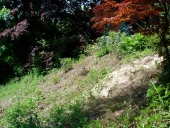





















 we will be using the area to grow in but the majority of that area will have to be used for our infrastructure. The small clean spring and the stone shed are there so it makes sense to build everything else around them. The left hand side of the blue area is also sheltered by some mature trees on the neighbours land so it doesn't get as much sunlight as the yellow area, which gets sun all day long.
we will be using the area to grow in but the majority of that area will have to be used for our infrastructure. The small clean spring and the stone shed are there so it makes sense to build everything else around them. The left hand side of the blue area is also sheltered by some mature trees on the neighbours land so it doesn't get as much sunlight as the yellow area, which gets sun all day long. 




















|
Give a man a gun and he'll rob a bank. Give a man a bank and he'll rob everyone. Even tiny ads:
The new gardening playing cards kickstarter is now live!
https://www.kickstarter.com/projects/paulwheaton/garden-cards
|




